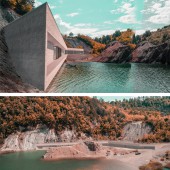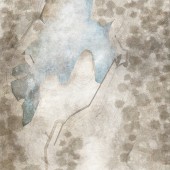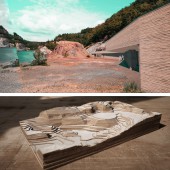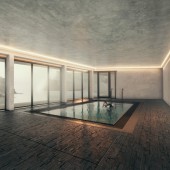
| THE AWARD |
| CATEGORIES |
| REGISTRATION |
| SUBMIT YOUR WORK |
| ENTRY INSTRUCTIONS |
| TERMS & CONDITIONS |
| PUBLICATIONS |
| DATES & FEES |
| METHODOLOGY |
| CONTACT |
| WINNERS |
| PRESS ROOM |
| GET INVOLVED |
| DESIGN PRIZE |
| DESIGN STORE |
| THE AWARD | JURY | CATEGORIES | REGISTRATION | PRESS | WINNERS | PUBLICATIONS | ENTRY INSTRUCTIONS |
Follower Form Diver Base of Rudabánya by Nándor Bence Krajnyák |
Home > Winners > Design #74549 >Interview |
 |
|
FS: What is the main principle, idea and inspiration behind your design?
NK: The pond of Rudabánya lies in the artificial basin of the late quarry which suits well for rescue divers to practice thanks to the capabilities of the lake. The artificial intervention transformed the character of the once untouched landscape. However, the altered terrain has gradually been recaptured by nature. The purpose of the planned building is influencing this reversal effect as little as possible. The result is a form that follows the line of the scarp near the lake. In this way the base can conform to the surrounding nature and connect directly to the water at the same time.
FS: What has been your main focus in designing this work? Especially what did you want to achieve?
NK: The base of the project was a paradox situation. The artificial intervention significantly transformed the character of the once untouched landscape, then the altered terrain has gradually been recaptured by nature. So the challenge was making a huge-scale intervention into an environment which is recaptured by nature and fitting it as much as it is possible.
FS: How long did it take you to design this particular concept?
NK: The design was made for 4 months between February and May in 2018.
FS: Why did you design this particular concept? Was this design commissioned or did you decide to pursuit an inspiration?
NK: The main idea of the function and location was created by Department of Industrial and Agricultural Building Design at Budapest University of Technology and Economics - Faculty of Architecture.
FS: What made you design this particular type of work?
NK: Since the main idea was created by a department, there were made several projects by students. I think the particularity of my work is that I made a huge emphasize on respecting the surrounding nature. The location of the late mine is finally recaptured by nature, but there is also a demand to place there a new function. So the purpose was to make the building as invisible and fitting as possible and in this way it can respect nature.
FS: Where there any other designs and/or designers that helped the influence the design of your work?
NK: During the creation of the concept I read ‘Landscrapers’ by Aaron Betsky which influenced the project. I also had a few reference buildings such as ‘Tverrfjellhytta’ by Snøhetta or ‘House in Wales’ by Future Systems.
FS: Who is the target customer for his design?
NK: The quarry pond lies in the artificial basin of the late mine, said to be one of the deepest lakes of Hungary. The water temperature is quite cold therefore it suits well for practicing rescue divers as well for learning other deep diving activities thanks to the depths and dangers of the lake. The base was planned on the southwestern part of the lake which area is more shallow and even warmer in summer time than the other parts of it. Therefore, it serves not just rescue divers, but any open water divers or totally junior divers too.
FS: How did you come up with the name for this design? What does it mean?
NK: The reply to the concept was a volume that follows the line of the scarp near the lake. That was the reason to call the project ‘Follower Form’.
FS: Which design tools did you use when you were working on this project?
NK: I created the 3d model in ArchiCAD. The visualizations were made with Twinmotion, Adobe Photoshop and Lightroom.
FS: What is the most unique aspect of your design?
NK: May the most unique aspect of the design is the purpose of invisibility and fusion, on the contrary, in most situations of a built environment it is not usually a main goal.
FS: Who did you collaborate with for this design? Did you work with people with technical / specialized skills?
NK: This was a student project so I had tutors to help during the designing process. The architectural part of the project was made with the guidance of Iván Nagy. The construction part of the project was made with the guidance of Zoltán Páricsy, Zsolt Huszár, Dr. Krisztina Tóth and Lajos Gyurcsovics.
FS: What is the role of technology in this particular design?
NK: It took many various and special technologies in several ways in order to realize the building. Securing the excavation pit from the mass of the scarp was conceived using steel sheet wall piling. Building above the water inquires special concrete placing methods and drilling precast concrete piles for foundation. For the deep pools constructed of reinforced concrete, a special waterproofing system is needed. Besides the appearance of the base aspires simplicity and sobriety, therefore where it was possible, the raw finished reinforced concrete structure stands rough. In consideration of the location it was subservient to take increased care for designing questions touching protection. Ones that were solved by applying massive, reinforced concrete pusher-gates and windows with quite narrow width. In this way the base can be absolutely closed if it is not in service.
FS: Is your design influenced by data or analytical research in any way? What kind of research did you conduct for making this design?
NK: Learning the site and surroundings, I had great use of the book of Landscrapers by Aaron Betsky getting to learn methods of ethical human intervention on the land. The finished plan inquired accented attentions touching environmentally friendly and cost-efficient building process and choice of materials used. The special location demands special applied systems. This statement includes the working of the building in a sustainable way: either the conscious management of the water from the lake, or recycling greywater, even applying biological sewage treatment systems for instance.
FS: What are some of the challenges you faced during the design/realization of your concept?
NK: Making a huge-scale intervention into an environment which is recaptured by nature and fitting it as much as it is possible. The result is a form that follows the line of the scarp through the connecting edge of the plain and slope parts. The spaces and rooms of the building are well-useable, they are connected to the water, yet the base feels reserved as well. By its roof the arriving touring people can discover inexperienced lanes. The purpose of the project was to design a fitting, more adaptable intervention. By which the location can gain a new interpretation which ultimately can lead to the prosperity of local tourism and the proper use of the site.
FS: How did you decide to submit your design to an international design competition?
NK: The design has been awarded on Media’s Architectural Prize 2018 in Budapest, Hungary. After the recognition at home I would like to take a step forward and show the project on international level.
FS: What did you learn or how did you improve yourself during the designing of this work?
NK: The most important thing I get during the designing that I got to know really close with landscape architecture. Since I made the project, I follow this part of architecture with much more interest. The special location required special solutions, therefore I knew several different and unusual technologies and I could also improve my modelling skills thanks to the individual landscape and function.
FS: Thank you for providing us with this opportunity to interview you.
A' Design Award and Competitions grants rights to press members and bloggers to use parts of this interview. This interview is provided as it is; DesignPRWire and A' Design Award and Competitions cannot be held responsible for the answers given by participating designers.
| SOCIAL |
| + Add to Likes / Favorites | Send to My Email | Comment | View Press-Release |





